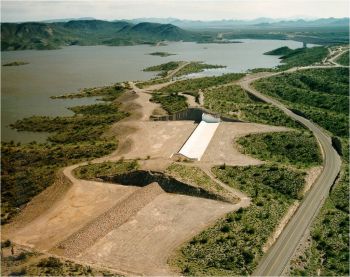Controlled Spillways: Difference between revisions
No edit summary |
No edit summary |
||
| Line 22: | Line 22: | ||
*[[Fuseplug Spillways]] | *[[Fuseplug Spillways]] | ||
*[[Fusegate Spillways]] | *[[Fusegate Spillways]] | ||
*[[Gated spillways]] | *[[Gates/Bulkheads|Gated spillways]] | ||
*[[Siphon Spillway]] | *[[Siphons|Siphon Spillway]] | ||
==Best Practices Resources== | ==Best Practices Resources== | ||
Revision as of 22:22, 2 December 2022

|
| A fuseplug emergency spillway (bottom) at the New Waddell Dam. (Wikipedia) |
“A controlled crest is one that includes gates which are used to control the flow; the uncontrolled crest is one unencumbered by gates”. [1] “Controlled spillways include crest gates that serve as a movable damming surface allowing the spillway crest to be located below the normal operating level of a reservoir or channel”.[2]
“For controlled spillways that are not integral with a concrete dam (i.e., located away from the dam on or through abutments, or on or through reservoir rim), existing topography must provide adequate space without excessive excavation. Also, the existing topography must allow appropriate orientation (alignment of the spillway between the reservoir and downstream river or stream) of the conveyance feature and terminal structure. Additionally, economics will come into play for all controlled spillways”.[3]
Types of Controlled Spillways
Best Practices Resources
![]() Design of Spillway Tainter Gates (EM 1110-2-2702) (U.S. Army Corps of Engineers)
Design of Spillway Tainter Gates (EM 1110-2-2702) (U.S. Army Corps of Engineers)
![]() Hydraulic Design of Spillways (EM 1110-2-1603)
Hydraulic Design of Spillways (EM 1110-2-1603)
Citations:
Revision ID: 4830
Revision Date: 12/02/2022
